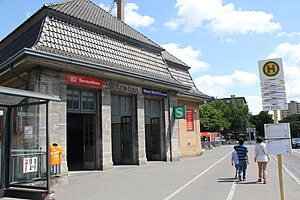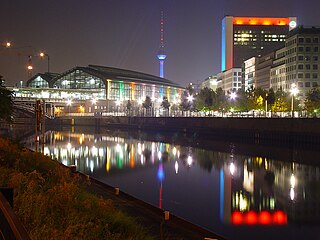
The Berlin S-Bahn is a rapid transit railway system in and around Berlin, the capital city of Germany. It has been in operation under this name since December 1930, having been previously called the special tariff area Berliner Stadt-, Ring- und Vorortbahnen. It complements the Berlin U-Bahn and is the link to many outer-Berlin areas, such as Berlin Brandenburg Airport. As such, the Berlin S-Bahn blends elements of a commuter rail service and a rapid transit system.
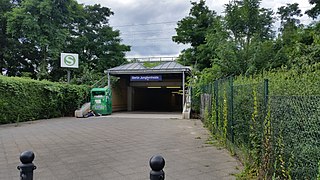
Berlin Jungfernheide is a railway station located at Charlottenburg-Nord, in the Charlottenburg-Wilmersdorf district of Berlin, served by the S-Bahn lines S41 and S42, the U-Bahn line U7 and Regional-Express trains of the Deutsche Bahn. Its name literally translates into "maidens' heathland"; it was named after the Jungfernheide, a former large forest in the proximity of this station.
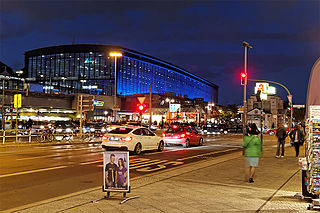
Berlin Zoologischer Garten station is a railway station in Berlin, Germany. It is located on the Berlin Stadtbahn railway line in the Charlottenburg district, adjacent to the Berlin Zoo.

Berlin Schönhauser Allee is a railway station in the Prenzlauer Berg district of Berlin. It is located on the Berlin U-Bahn line U2 and also on the Ringbahn . Built in 1913 by A.Grenander opened as "Bahnhof Nordring". As the station was well accepted the roof was elongated in 1925 and a new entrance built. In 1936 the station was named "Schönhauser Allee". On an average day approximately 500 trains and more than 26000 people cross this station.

Kaiserdamm is a Berlin U-Bahn station located on line U2. It is linked to the Messe Nord/ICC station of the Berlin S-Bahn.

Tempelhof is a railway station in the district of Berlin with the same name. It is served by the S-Bahn lines S41, S42, S45 and S46 and the U-Bahn line U6. The S-Bahn station is on an embankment at the junction of Tempelhofer Damm and Bundesautobahn 100, about 1 km south of the entrance to the former Tempelhof Airport. The U-Bahn station, officially called Tempelhof (Südring), is under Tempelhofer Damm immediately south of the S-Bahn station.
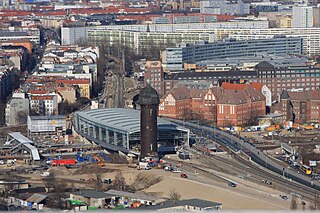
Berlin Ostkreuz station is a station on the Berlin S-Bahn suburban railway and the busiest interchange station in Berlin. It is in the former East Berlin district of Friedrichshain, now part of the borough of Friedrichshain-Kreuzberg. A smaller part of the station is in Rummelsburg, part of the borough of Lichtenberg. The station is a Turmbahnhof with the Berlin–Frankfurt (Oder) railway and the Prussian Eastern Railway on the lower level and the Berlin Ringbahn on the upper level. It is used by a total of around 235,000 passengers every day on eight lines, entering or leaving.

The Berlin Stadtbahn is the historic east-west elevated railway of Berlin. It runs from Ostbahnhof in the east to Charlottenburg in the west, connecting several of the most major sights of the German capital. The line is protected cultural heritage since 1995. It is often defined more simply as the slightly longer route between Ostkreuz and Westkreuz, although this is not technically correct.

The Ringbahn is a 37.5 km (23.3 mi) long circle route around Berlin's inner city area, on the Berlin S-Bahn network. Its course is made up of a pair of tracks used by S-Bahn trains and another parallel pair of tracks used by various regional, long distance and freight trains. The S-Bahn lines S41 and S42 provide a closed-loop continuous service without termini. Lines S45, S46 and S47 use a section of the southern and western ring, while lines S8 and S85 use sections of the eastern ring. The combined number of passengers is about 400,000 passengers a day. Due to its distinctive shape, the line is often referred to as the Hundekopf.

Westend is a locality of the Berlin borough Charlottenburg-Wilmersdorf in Germany. It emerged in the course of Berlin's 2001 administrative reform on the grounds of the former Charlottenburg borough. Originally a mansion colony, it is today a quite densely settled, still affluent territory adjacent to Berlin's inner city in the east.
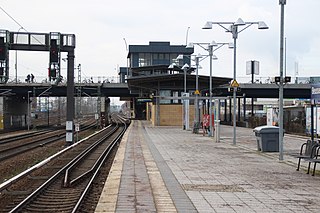
Beusselstraße is a Berlin S-Bahn station in the Moabit district in the Mitte borough of Berlin. It is located at the Beussel bridge, which carries the street of Beusselstrasse over the Berlin Ringbahn. It is served by the S-Bahn lines S41 and S42. It is additionally served by the line S46 on weekends.

Westend is a station in the Charlottenburg district of Berlin. It is located on the Ringbahn circle line, served by the S-Bahn lines S41, S42 and S46. It is named after the Westend locality, which is immediately adjacent to the station grounds. The entire station area was opened—as Charlottenburg-Westend—in several stages from 15 November 1877, but it has since been reduced to an S-Bahn platform and a pair of long-distance tracks. The station was closed temporarily in 1980 because of the S-Bahn strike. A platform on the Ringbahn was reopened in 1993 for S-Bahn traffic. The restoration of all of the station infrastructure is not planned.

Berlin Westkreuz is a station in the Charlottenburg district of Berlin. It is served by the S-Bahn lines S3, S41, S42, S46, S5, S7 and S9 and so represents a major interchange point on the Berlin S-Bahn network. It lies at the opposite end of the Stadtbahn to Ostkreuz and is one of the four main stations on the Ringbahn.

The Internationales Congress Centrum Berlin, located in the Westend locality of the Berlin borough of Charlottenburg-Wilmersdorf, was one of the largest conference centres in Germany. It is used for conventions, theatrical productions and concerts. In April 2014 it was closed in order to remove asbestos contamination, and remains closed as of 2024. In October 2021, it was temporarily reopened for the art project The Sun Machine Is Coming Down as part of the Berliner Festspiele.

Berlin has developed a highly complex transportation infrastructure providing very diverse modes of urban mobility. 979 bridges cross 197 kilometers of innercity waterways, 5,334 kilometres (3,314 mi) of roads run through Berlin, of which 73 kilometres (45 mi) are motorways. Long-distance rail lines connect Berlin with all of the major cities of Germany and with many cities in neighboring European countries. Regional rail lines provide access to the surrounding regions of Brandenburg and to the Baltic Sea.

Bus transport is the oldest public transport service in Berlin, the capital city of Germany, having been introduced in 1846. Since 1929, services have been operated by the Berlin Transport Company, although during the Cold War-era division of the city they operated in West Berlin only. In East Berlin the public transport agency split off from the BVG and rebranded as BVB, operating the buses in the Soviet sector of Berlin.

The Spandau suburban railway is a suburban railway in Berlin. It is an extension of the Stadtbahn from Westkreuz to Spandau. Its last kilometre runs parallel with the Lehrte and Hamburg lines. It is currently used by Berlin S-Bahn lines S3 and S9.

Siemensstadt-Fürstenbrunn station was a suburban station on the Berlin–Hamburg railway in Westend, a locality of the Charlottenburg-Wilmersdorf borough in Berlin. It was primarily built for workers at its nearby Siemens Works in the neighbouring quarter of Siemensstadt.

The Berlin S-Bahn began on 8 August 1924 with the first section from Stettiner Vorortbahnhof to Bernau using steam locomotives. On 13 August 1961 it was broken up when the Berlin Wall was built, resulting in two sections: the eastern part and the western part. The western part experienced a massive strike which resulted in closure of several stations, after declining use. Attempts were made to reopen at various times but in the end, only three lines were finally opened after the strike. Since 9 November 1989, when the Berlin Wall was opened, the Berlin S-Bahn began to expand rapidly with their budgetary costs.

The Zentraler Omnibusbahnhof Berlin is a central bus station located at the Funkturm Berlin in the Berlin district Westend of the Charlottenburg-Wilmersdorf district. It was initiated by Gustav Severin and went into operation in May 1966. It replaced the bus station on the Stuttgarter Platz since 1951 for bus traffic to West Germany.
